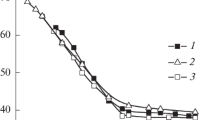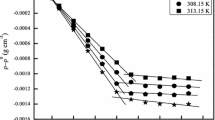Abstract
The aim of this work is to discuss the mechanisms involved in amino acidsolubilization in cationic reversed micelles. A simple mechanism was assumedin which the amino acid solubilization is mediated by an ion-exchangeprocess between the amino acid and the surfactant counter ion neglecting theeffect of the reversed micellar structure. Based on this mechanism a simplemodel to predict equilibrium was developed and applied to the solubilizationof amino acids with different structures. It was found that solubilizationof hydrophilic and slightly hydrophobic amino acids can be described by anion-exchange mechanism and the amino acid equilibrium concentration can bedetermined for different experimental conditions using this model. However,solubilization of hydrophobic amino acids can not be described by a simpleion-exchange model. In this case hydrophobic contributions play an importantrole in amino acid solubilization and must be considered in the overallsolubilization process. This hydrophobic contribution was evaluated bydetermination of an interfacial partition coefficient. The overall aminoacid extraction was determined using distribution coefficients of all theamino acid forms and considering their dependence on ionic strength.
Similar content being viewed by others
References
Adachi M, Harada M, Shioi A and Sato Y (1991) Extraction of amino acids to microemulsion. J. Phys. Chem. 95: 7925–7931
Cussler E L (1989) Bioseparations, especially by hollow fibers. Ber. Busenges. Phys. Chem. 93: 944–948.
Dekker M, van't Riet K, Weijers S R, Baltussen J W A, Laane C and Bijsterbosch B H (1986) Enzyme recovery by liquid-liquid extraction using reversed micelles. Chem. Eng. J. 33: B27–B33.
Dekker M, Hilhorst R and Laane C (1989) Extracting enzymes by reversed micelles. Anal. Biochem. 178: 217–226.
Eyal A M and Bressier E (1993) Industrial separation of carboxylic and amino acids by liquid membranes: applicability, process considerations and potential advantages. Biotechnol. Bioeng. 41: 287–295.
Göcklen K E and Hatton T A (1985) Protein extraction using reversed micelles. Biotechnol. Progr.1: 69–74.
Hatton T A (1989) Reversed micellar extraction of proteins. In: Scamehorn, J F and Harwell J H (eds) Surfactant-Based Separation Process, Vol. 33 (pp. 55–90). Marcel Dekker, New York
Israelachvili J N, Mitchell D J and Ninham B W (1976) J. Chem. Soc., Faraday Trans. 2 72: 1525.
Krei G A and Hustedt H (1992) Extraction of enzymes by reverse micelles. Chem. Eng. Sci. 47: 99–111.
Lange's Handbook of Chemistry (1979), 12th edition, John A. Dean (ed) McGraw Hill Book Company.
Leodidis E B and Hatton T A (1990a) Amino acids in AOT reversed micelles. l. Determination of interfacial partition coefficients using the phase-transfer method. J. Phys. Chem. 94: 6400–6411.
Leodidis E B and Hatton T A (1990b) Amino acids in AOT reversed micelles. 2. The hydrophobic effect and hydrogen bonding as driving forces for interfacial solubilization. J. Phys. Chem. 94: 6411–6420.
Leodidis E B (1990) Solubilization of Hydrophilic Molecules in W/O Microemulsions: The Phase-Equilibrium Experiments As an Analytical Tool. Ph. D. Thesis, MIT, Cambridge, MA.
Luisi P L, Bonner F J, Pelligrini A, Wiget P and Wolf R (1979) Micellar solubilization of proteins in aprotic solvents and their spectroscopic characterization. Helv. Chim. Acta 62: 740–753.
Luisi P L, Giomini M, Pileni M P a nd Robinson B H (1988) Reversed micelles as hosts for proteins and small molecules. Biochim. Biophys. Acta 947: 209–246
Meier P, Imre E, Fleshar M and Luisi P L (1984) Further investigations on the micellar solubilization of biopolymers in apolar solvents. In: Mittal M K and Lindman B (eds) Surfactants in Solution, Vol. 2 (pp. 999). Plenum Press, New York.
Mitchell D J and Ninham BW(1981) J. Chem. Soc., Faraday Trans. 2, 77: 601.
Thien M P and Hatton T A (1988) Liquid emulsion membranes and their applications in biochemical processings. Sep. Sci. Technol. 23: 819.
Author information
Authors and Affiliations
Rights and permissions
About this article
Cite this article
Margarida Cardoso, M., Barradas, M.J., Carrondo, M.T. et al. Mechanisms of amino acid partitioning in cationic reversed micelles. Bioseparation 7, 65–78 (1998). https://doi.org/10.1023/A:1008080215915
Issue Date:
DOI: https://doi.org/10.1023/A:1008080215915




